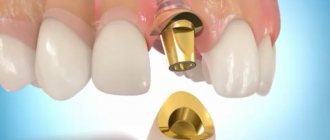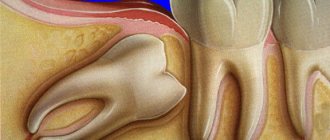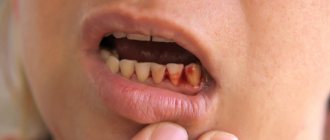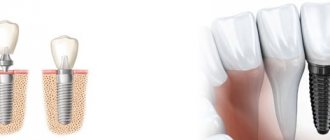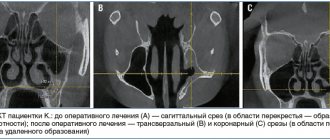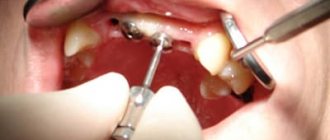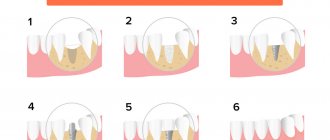Why are sutures required after wisdom tooth removal?
Extraction of the third molar requires suturing. It is not always possible to save the patient from the procedure described above. Even when working with high-quality equipment, a competent dentist will encounter problems. The third molar is secured with the help of two roots, the removal of which requires making a few incisions, and then removing the tooth body from the gum. Sutures are also applied if there are clinical signs of gum inflammation. Swelling is considered a natural process for the body, due to damage to the gums during incisions. The suturing procedure is also a preventive measure, which reduces the risk of infectious pathological syndrome; pathogenic bacteria do not penetrate into the open wound. The smaller the size of the wound, the lower the likelihood of infection, the age the rate of regeneration. Regardless of the type of thread used, suturing takes a short period of time. Self-absorbable threads are a more preferable option; they do not need to be removed and re-injure the gums.
Complications after osteoplasty and sinus lifting
The main postoperative complications include the appearance of pain, swelling at the surgical site and surrounding tissues, bleeding, numbness and paresthesia
Suture dehiscence after sinus lifting and bone grafting is not as common as pain and swelling, but is also a rather unpleasant condition. Typically, suture dehiscence occurs due to mechanical damage or trauma at the surgical site when the doctor’s recommendations are not followed. The cause may also be a manufacturing defect in the thread or incorrectly chosen tactics in using knots. But this happens extremely rarely, only among insufficiently experienced specialists. Violation of the regime in the postoperative period:
- Using a straw when taking food and water;
- Puffing out cheeks, whistling, singing and screaming;
- Constant tugging at the surgical site and nodes with the tongue;
- Excessive rinsing with antiseptics and other solutions, which can cause unnecessary pressure in the mouth;
- Intensive use of a toothbrush to clean the tongue, cheeks and teeth;
- Rough food that is difficult to chew, which can cause injury to the suture;
As a result, the wound will open and, most likely, infection will occur at the osteoplasty site and in the surrounding tissues. This will naturally cause local inflammation, pain, fever and astheno-vegetative syndrome. All this is one side of the coin, the other side is that after the infectious agent enters the wound, an inflammatory reaction will occur and the stitches will separate. What can cause an inflammatory reaction:
- Non-compliance with the regimen after surgery;
- Refusal of antibiotics and anti-inflammatory drugs, which will reduce pain and protect against the development of infection;
- Poor or lack of oral hygiene;
- Visiting sports sections, saunas, baths, swimming pools;
- Smoking and drinking alcoholic beverages.
If this situation occurs, you should immediately seek medical help, as all this can lead to the loss of the implant. And then there is a long period of rehabilitation of the bone and soft tissues, repeated osteoplasty, a period of healing and recovery. Therefore, you should only contact qualified specialists who, in addition to a first-class operation, will also be able to correctly explain the importance of the recovery phase after surgery in order to eliminate all possible complications.
How to understand that complications have arisen after suturing?
Alarming symptoms after removing the “eight” are as follows:
- heavy bleeding that lasts more than a day;
- severe pain, throbbing pain that prevents you from sleeping or leading a normal life;
- very large swelling;
- redness in the intervention area;
- blood in saliva in the first three days after the intervention;
- elevated body temperature.
In all these cases, you must consult your doctor. It is possible that stitches will have to be stitched again to avoid complications.
Indications for suturing
It is necessary to sew up the hole after tooth extraction if extraction is performed:
- dystopic and impacted dental units with a destroyed crown and severely curved roots,
- wisdom teeth
Another indication for wound suturing is to prevent severe bleeding. The doctor may decide to use stitches if:
- the patient is diagnosed with gingivitis or periodontitis,
- there is a suspicion of a blood clotting disorder.
Useful tips for oral care
- hold the cotton swab applied by the doctor for 20-30 minutes;
- within 2-3 hours after surgery, be sure to apply cold compresses to reduce tissue swelling;
- carry out oral baths (not to be confused with rinsing) with antiseptic drugs for 3-5 days: “Miramistin”, “Chlorhexidine 0.5%” or other drugs prescribed by a doctor can be used as medicinal solutions;
- after 3-5 days, start using a toothbrush - only a soft one for the operated area, as well as a new one, without bacteria on it. The teeth of the opposite jaw can be brushed immediately, the main thing is to avoid the area of the extracted tooth;
- chew food on the side opposite the injured area;
- You can drink water immediately, preferably warm;
- You can eat only after the anesthesia wears off, that is, after 2-3 hours;
- Lead a quiet lifestyle, try to avoid physical activity and heavy lifting for 5-7 days.
Types of suture materials in surgical dentistry
In dental clinics, different types of threads are used to fix the edges of the sockets during tooth extraction:
- Synthetic, self-resorbable due to hydrolysis reaction. These are threads with a hypoallergenic composition that guarantee reliable fixation of the wound edges for about a month.
- Natural, absorbable, enzyme-based surgical suture material. The stitches disappear in 10-100 days, and the thread segments are safely removed from the human body.
- Synthetic regular threads. Made from silk, nylon, polyester. They require mechanical removal after complete healing of the hole.
What not to do after suturing.
- don't rinse your mouth! Mouth baths in the first 3-5 days are more than enough;
- do not use hot compresses! This is fraught with the appearance of edema and the development of inflammation;
- do not create a vacuum in your mouth: do not puff out your cheeks, sneeze, blow your nose and spit very carefully;
- do not pick the wound, do not touch the clot with your tongue;
- do not drink or eat hot or cold food, only warm food;
- try to quit smoking for at least 2-3 days after surgery;
- Do not drink alcohol for 2-3 days - it does not promote tissue repair. Also rule it out if your doctor has prescribed a course of antibiotics;
- Do not overcool or overheat - give up sports exercises, swimming pools, saunas for 5-7 days.
When to remove gum sutures
Even if the wound was sutured with a self-absorbing thread, it is worth checking with your doctor whether it needs to be removed and when. The surgeon must ensure that the operation performed does not cause late complications. Therefore, you need a second visit to him after 7-10 days to determine how many days later to remove the sutures from the gums.
If there is no swelling, redness, or pain, the doctor will remove the stitches. If tissue healing is incomplete, you may need another visit in 2-3 days, during which the material used to close the wound will be removed.
Does it hurt to take it off?
When the suture thread is removed, the patient feels discomfort. Pain when pulling out suture material is rare, due to individual sensitivity or in the presence of a complication in the form of inflammation. If the patient's pain threshold is reduced, superficial anesthesia with Novocaine or Lidocaine spray is used.
How to remove sutures on the gums
Before removing stitches:
- The surgeon will treat the oral cavity with an antiseptic.
- Examine the mucous membrane of the oral cavity: it is necessary that there is no pain, fever, redness, swelling, and no fluid or pus is released from the wound area.
- The thread is cut with a special dental instrument. When the seam is continuous, the cut will be in several places; if it is intermittent, then all the stitches will be cut in half.
- Using fingers or tweezers, the surgeon will pull out pieces of thread and check how well the scar is formed on the wound.
After removing the stitches, the patient will rinse their mouth with an antiseptic.
For 1–3 days, unpleasant sensations in the jaw and gums are possible when moving.
The wound after tooth extraction heals completely within 2–3 weeks. In young people this process is faster. The sockets of single-rooted teeth can heal completely on the 14th day, multi-rooted ones - by the 20th day after surgery.
In case of purulent complications, healing will be delayed for a week for a single-rooted tooth, and 2 for a multi-rooted one.
The more traumatic the operation was, the larger the volume of tissue that was subjected to intervention, the longer the healing.
The surgeon still removes the absorbable sutures so that they, being on the gums for a long time, do not provoke inflammation.
Removing the suture material too early may prevent a clot from fully forming in the wound. In this case, inflammation is also possible.
Sometimes patients get in the way of the threads, and the question arises of how to remove the sutures from the gums on their own, at home, if there is no pain or swelling. What to do if the surgeon is far away, and it’s impossible to tolerate when the threads become hard and rub against the tongue or gums, causing irritation of the mucous membrane?
In principle, the stitches can be removed by the patient himself. But this is fraught with infection in the wound.
At home, you must follow all the rules of asepsis and antisepsis; you cannot keep your instruments sterile. Safe removal of the threads used to suture the gum wound is only possible by a dentist.
Types of material and types of stitches
Because permanent unit extraction is a complex procedure comparable to other forms of surgery, adherence to protocol is an important factor to ensure its safety. A fairly common occurrence is a wide crown and a deepened root part of the tooth. Such a structure requires additional incisions during tooth extraction, which are sutured at the end of the operation. The use of high-quality suture material is another significant point that affects the outcome of the entire procedure.
The key goal of postoperative manipulation is to provide the conditions necessary for rapid tissue healing. The material used for suturing the hole is a foreign body that remains in the soft tissues until they are completely restored. In modern dentistry, two categories of sutures are used:
- Absorbable sutures are threads for surgical operations, characterized by a sterile and durable structure, immunity to the transmission of infectious pathologies, and ease of use. Made from synthetic or natural materials, and do not require removal after regeneration;
- Non-absorbable sutures - as a rule, are a polymer or silk thread that is biologically compatible with the gum tissue. Stable and inexpensive, the suture material does not cause adverse reactions during wear, but requires repeated medical intervention after restoring the natural structure of the area that underwent surgery.
The choice of suturing technology depends on the specifics of the clinical case, and involves the use of interrupted or permanent stitches. As a rule, in most situations, the first method is used, when each stitch is separated from the rest and secured with a special knot. Continuous suturing reduces the duration of application, but is accompanied by the risk of damage to the threads and the entire structure as a whole.
